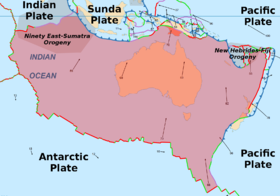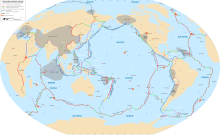Australian Plate
| Australian Plate | |
|---|---|
 | |
| Type | Major |
| Approximate area | 47,000,000 km2 (18,000,000 sq mi)[1] |
| Movement1 | northeast |
| Speed1 | 62–70 mm/year |
| Features | Australia, New Guinea, New Zealand, Indian Ocean |
| 1Relative to the African Plate | |
The Australian Plate is a major tectonic plate in the eastern and, largely, southern hemispheres. Originally a part of the ancient continent of Gondwana, Australia remained connected to India and Antarctica until approximately 100 million years ago when India broke away and began moving north. Australia and Antarctica began rifting 85 million years ago and completely separated roughly 45 million years ago.[2]
The Australian plate later fused with the adjacent Indian Plate beneath the Indian Ocean to form a single Indo-Australian Plate. However, recent studies suggest that the two plates have once again split apart and have been separate plates for at least 3 million years and likely longer.[3] The Australian Plate includes the continent of Australia, including Tasmania, as well as portions of New Guinea, New Zealand, and the Indian Ocean basin.
Scope[]
The continental crust of this plate covers the whole of Australia, the Gulf of Carpentaria, southern New Guinea, the Arafura Sea, the Coral Sea. The continental crust also includes northwestern New Zealand, New Caledonia and Fiji. The oceanic crust includes the southeast Indian Ocean, the Tasman Sea, and the Timor Sea]. The Australian Plate is bordered (clockwise) by the Eurasian Plate, the Philippine Plate, the Pacific Plate, the Antarctic Plate, the African Plate and the Indian Plate.
Geography[]
The northeasterly side is a complex but generally convergent boundary with the Pacific Plate. The Pacific Plate is subducting under the Australian Plate, which forms the Tonga and Kermadec Trenches, and the parallel Tonga and Kermadec island arcs. It has also uplifted the eastern parts of New Zealand's North Island.
The continent of Zealandia, which separated from Australia 85 million years ago and stretches from New Caledonia in the north to New Zealand's subantarctic islands in the south, is now being torn apart along the transform boundary marked by the Alpine Fault.
South of New Zealand the boundary becomes a transitional transform-convergent boundary, the Macquarie Fault Zone, where the Australian Plate is beginning to subduct under the Pacific Plate along the Puysegur Trench. Extending southwest of this trench is the Macquarie Ridge.
The southerly side is a divergent boundary with the Antarctic Plate called the Southeast Indian Ridge (SEIR).
The subducting boundary through Indonesia is not parallel to the biogeographical Wallace line that separates the indigenous fauna of Asia from that of Australasia. The eastern islands of Indonesia lie mainly on the Eurasian Plate, but have Australasian-related fauna and flora. Southeasterly lies the Sunda Shelf.
Origins[]
Depositional age of the Mount Barren Group on the southern margin of the Yilgarn Craton and zircon provenance analysis support the hypothesis that collisions between the Pilbara–Yilgarn and Yilgarn–Gawler Cratons assembled a proto-Australian continent approximately 1,696 million years ago (Dawson et al. 2002).[4]
See also[]
- List of earthquakes in Australia
- List of earthquakes in India
- List of earthquakes in Indonesia
- List of earthquakes in New Zealand
- List of earthquakes in Papua New Guinea
- List of earthquakes in Samoa
- List of earthquakes in Tonga
- List of earthquakes in Vanuatu
- Sunda Plate – A minor tectonic plate including most of Southeast Asia
References[]
- ^ "Sizes of Tectonic or Lithospheric Plates". Geology.about.com. 2014-03-05. Retrieved 2015-12-25.
- ^ "New Look at Gondwana's Breakup". Livescience.com. 2013-07-05. Retrieved 2015-12-25.
- ^ Stein, Seth; Sella, Giovanni F.; Okai, Emile A. (2002). "The January 26, 2001 Bhuj Earthquake and the Diffuse Western Boundary of the Indian Plate" (PDF). Plate Boundary Zones. Geodynamics Series. American Geophysical Union. pp. 243–254. doi:10.1029/GD030p0243. ISBN 9781118670446. Retrieved 2015-12-25.
- ^ Dawson, Galvin C.; Krapež, Bryan; Fletcher, Ian R.; McNaughton, Neal J.; Rasmussen, Birger (2002). "Did late Palaeoproterozoic assembly of proto-Australia involve collision between the Pilbara, Yilgarn and Gawler Cratons? Geochronological evidence from the Mount Barren Group in the Albany–Fraser Orogen of Western Australia". Precambrian Research. 118 (3–4): 195–220. doi:10.1016/S0301-9268(02)00110-9. ISSN 0301-9268.
- Tectonic plates
- Geology of the Indian Ocean
- Geology of Australia
